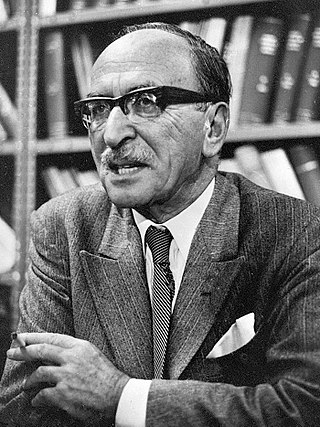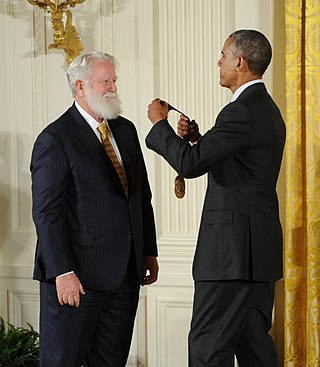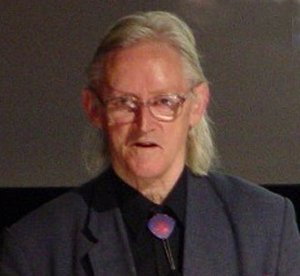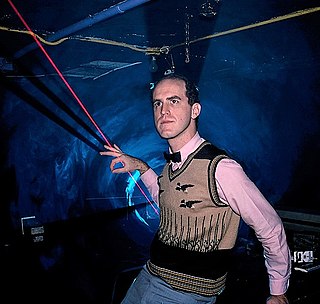
Holography is a technique that enables a wavefront to be recorded and later reconstructed. It is best known as a method of generating real three-dimensional images, but also has a wide range of other applications. In principle, it is possible to make a hologram for any type of wave.

Dennis Gabor was a Hungarian-British electrical engineer and physicist, most notable for inventing holography, for which he later received the 1971 Nobel Prize in Physics. He obtained British citizenship in 1934, and spent most of his life in England.

Robert W. Irwin is an American installation artist who has explored perception and the conditional in art, often through site-specific, architectural interventions that alter the physical, sensory and temporal experience of space.

James Turrell is an American artist known for his work within the Light and Space movement. Much of Turrell's career has been devoted to a still-unfinished work, Roden Crater, a natural cinder cone crater located outside Flagstaff, Arizona, that he is turning into a massive naked-eye observatory; and for his series of skyspaces, enclosed spaces that frame the sky.
Lloyd Cross is an American physicist and holographer.

Stephen Anthony Benton was the E. Rudge ('48) and Nancy Allen Professor of Media & Sciences, and the Director for Center for Advanced Visual Studies (CAVS) at Massachusetts Institute of Technology. He was the inventor of the rainbow hologram and a pioneer in medical imaging and fine arts holography. Benton held 14 patents in optical physics and photography, and taught media arts and sciences at MIT.

Australian Holographics was a laboratory based in Adelaide, South Australia. It was established in 1989 with the specific objective to produce high quality large format holograms. After two years of research and development, the company began commercial operations in 1991. The laboratory eventually shut down in 1998.
Hiro Yamagata is a painter/artist, based in Los Angeles, California.

Nicholas (Nick) John Phillips was an English physicist, notable for the development of photochemical processing techniques for the colour hologram. Holograms typically used to have low signal-to-noise ratios, and Phillips is credited as the pioneer of silver halide holographic processing techniques for producing high-quality reflection holograms.

Peter van Riper was a sound and light environment artist, musician and pioneer of laser art and holography.

Digital holographic microscopy (DHM) is digital holography applied to microscopy. Digital holographic microscopy distinguishes itself from other microscopy methods by not recording the projected image of the object. Instead, the light wave front information originating from the object is digitally recorded as a hologram, from which a computer calculates the object image by using a numerical reconstruction algorithm. The image forming lens in traditional microscopy is thus replaced by a computer algorithm. Other closely related microscopy methods to digital holographic microscopy are interferometric microscopy, optical coherence tomography and diffraction phase microscopy. Common to all methods is the use of a reference wave front to obtain amplitude (intensity) and phase information. The information is recorded on a digital image sensor or by a photodetector from which an image of the object is created (reconstructed) by a computer. In traditional microscopy, which do not use a reference wave front, only intensity information is recorded and essential information about the object is lost.
Specular holography is a technique for making three dimensional imagery by controlling the motion of specular glints on a two-dimensional surface. The image is made of many specularities and has the appearance of a 3D surface-stippling made of dots of light. Unlike conventional wavefront holograms, specular holograms do not depend on wave optics, photographic media, or lasers.

Yves Gentet is a French engineer and artist, known for the invention of a creative method of holograms in colour Ultimate and a 3D holographic printer Chimera.

Dieter Jung is a German artist working in the field of holography, painting and installation art. He lives and works in Berlin.
Wenyon & Gamble is the name used by the art team of Susan Gamble and Michael Wenyon.

Chris Levine is a UK-based artist, working in the field of light art.

Jason Sapan, also known as Dr. Laser is a holographer and actor who is the founder of Holographic Studios, the world's oldest gallery of holography, located in the borough of Manhattan in New York City. He is one of the pioneers of holography, and has also worked as an educator, recording engineer, artist, blogger, and actor. He has created portrait holograms of Andy Warhol, President Bill Clinton, Isaac Asimov, NYC Mayor Ed Koch, Prime Minister Edward Heath, Pierre Cardin, Sally Jessy Raphael, John Kenneth Galbraith, Phyllis Diller, Billy Idol, The Smothers Brothers, Phil Donahue, and John Cage. His corporate clientele include commissions for Mitsubishi, AT&T, Tag Heuer, Goodyear, IBM and NYU Medical Center.

Holographic Studios, located in the borough of Manhattan in New York City, is the world's oldest gallery of holography. It was founded in 1979 by Jason Sapan, one of the pioneers of holography. The storefront level gallery features the world's largest collection of motion image integral holograms. On display in the gallery are a variety of different types of holographic images, including a collection of celebrity hologram portraits. There are also cylindrical 360° floating images, multiple image holograms that change as you walk by, and computer generated holograms as well as a selection of novelty hologram items and stickers. Directly below the gallery is the laser laboratory where holograms are created. Holographic Studios creates custom holograms, holographic portraits, offers classes, and operates tours.
Margaret Benyon,, was a British artist. Trained as a painter, she was one of the first artists to use holography as a medium and had her first solo show of holograms in 1969. She was appointed to the Order of the British Empire in 2000 for her service to art and has been called "the mother of British holography".

Phillip K. Smith III is an American artist based out of Southern California. He primarily creates light-based work that draws upon ideas of light and space, form, color, light and shadow, environment, and change. Phillip K. Smith III received his Bachelor of Fine Arts and Bachelor of Architecture at the Rhode Island School of Design. Phillip K Smith III has worked on and created numerous large-scale sculptures across the country, as well as internationally. He has participated in numerous museum installations and shows around the world. His artwork is held in many important private collections as well as multiple museum's permanent collections. Phillip K. Smith III has often been compared to his predecessors such as Robert Irwin, James Turrell, Dan Flavin, Donald Judd, Craig Kauffman, Constantin Brancusi, Sol Lewitt, and Kenneth Noland.















